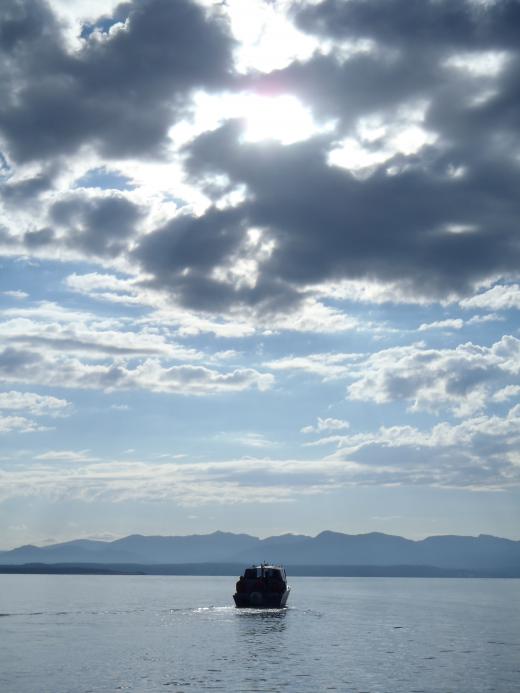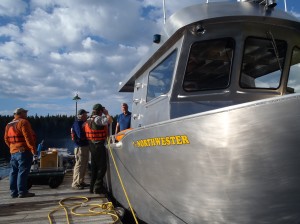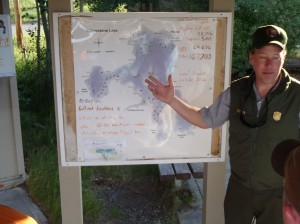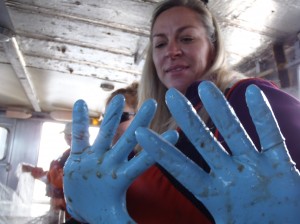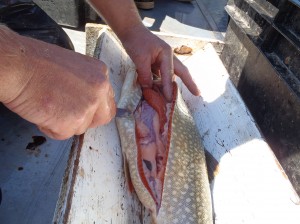TU Blogger Tour, Day One: Lake Trout Beware
Editor's note: In June, TU, along with Simms, the Yellowstone Park Foundation and the Outdoor Blogger Network, held an essay contest. Two winners were selected to attend the second annual TU Blogger Tour--this year's tour took place July 24-28 in Yellowstone National Park. By Chris Hunt You ever have one of those nights when something deep down inside you reminds you that morning's going to come awfully early and the unopened beer in your hand is best left as is? At 5:30 in the morning of July 24, I quietly thanked that little angel on my right shoulder for outsmarting the devil on my left the night before. Looking over the motley crew of bloggers, writers, industry reps and TU staffers gathered in the pre-dawn glow, I knew I wasn't the only one who wisely swapped the can of cold brew for bottle of water a few hours earlier. Chalk one up for the good guys. As the line of cars left the lot at Headwaters Lodge at Flagg Ranch, the sun was starting to light up the sky. We pointed our cars north and drove through the south entrance of Yellowstone National Park on our way to Yellowstone Lake. Todd Koel, head of Yellowstone's fisheries team, led the way up the Lewis River, slowing only once so the group could take in the sunrise as it shined brightly over a meadow full of grazing cow elk. I live in this area, and I get to visit the park often. But, for some reason, frequency doesn't tarnish the luster of driving through the park at sunrise. It's simply magical, and I'll always be grateful to the folks who came up with the brilliant idea of setting this amazing place aside for generations yet to come. I'm a direct beneficiary, and I could tell, as we slowed to admire nature's handiwork that morning, that I was among folks who felt the same way.
The Northwester, a Hickey Bros. boat, prepares to launch for a day of netting lake trout on Yellowstone Lake.
We arrived at the Bridge Bay Marina just before 7 0'clock--the sun had crested the mountains along the east shore of Yellowstone Lake giving the water a morning sparkle and illuminating the boats and skiffs tied securely to the docks. The bulk of us visited the little convenience store for coffee and breakfast, and then we gathered around Todd for a quick explanation of what we'd be seeing that day. As he worked through the numbers of lake trout the Park Service and its contractor, Hickey Bros. Fishing, had captured and killed since the netting season began in May, it began to sink in. The gorgeous high-country lake we were visiting is in trouble. Its native trout--the venerable Yellowstone cutthroat--is literally being eaten by invasive lake trout that somehow found their way into Yellowstone Lake sometime in the mid-1980s. It's a tale dripping with irony. The lakers--native to the Great Lakes and the lakes of central Canada--were first introduced into Lewis Lake, which, when it was first "discovered" by European Americans in the early 1800s, was fishless. These predators were put in Lewis and Shoshone lakes, along with brown trout and brook trout (also non-native) in the 1880s--their stocks were gathered from Lake Michigan. Today, Lewis Lake's lake trout serve as the best brood stock for returning lakers to the
Todd Koel, lead fisheries biologist in Yellowstone National Park, shows the group where the nets are set and explains how lake trout are being removed.
Great Lakes where their numbers, thanks, oddly enough, to non-native fish plantings and invasive species infestations over the last two centuries, have plummeted. Unfortunately, somebody in, say, 1983, thought it might be a good idea to take some of those Lewis Lake lake trout and put them in Yellowstone Lake. The first laker was caught by a recreational angler in Yellowstone Lake in 1984. Thousands--maybe millions--more have infested the lake since. In the National Park Service's Native Fish Conservation Plan released last year, it's believed that, since the lake trout invasion that started some 30 years ago, Yellowstone lake has lost as much as 99 percent of its spawning Yellowstone cutthroat trout. As Todd quickly explained to the gathering of about a dozen folks, lake trout don't truly replace Yellowstone cutthroat trout in the ecosystem. In other words, in the case of Yellowstone Lake, a fish isn't just a fish. Lakers live deep and are notorious piscavores. Yellowstone cutts live in relatively shallow waters (they're famous for being caught from the lake's shorelines), and they migrate into the lakes tributary rivers and streams to spawn. Lake trout spawn in the lake. So, when you consider the entire Yellowstone Lake ecosystem, the loss of the cutthroat trout affects more than just us anglers. With most of the spawning fish gone, there are no fish in the streams for the park's famous grizzly bears to eat during the spring spawn. There are no fish for otters, ospreys, eagles, coyotes, wolves, pelicans and other critters that depend on healthy fish runs for food every single year. Lake trout, because they live deep, spawn in the lake and eat cutthroat trout, are changing the entire environment of the park.
Heading out to net lake trout from the waters of Yellowstone Lake.
It was a sobering discussion. When Todd handed out life jackets and assigned us to a pair of Park Service work skiffs, I think the entire group was excited to be part of the effort to set things right. We were off to kill lake trout. Our first stop was a Park Service boat that runs a chain of gill nets throughout areas of the lake known as lake trout migration routes. The nets are set deep--some as deep as 40 meters--and left out for several nights. When they're hauled in, Park Service staffers and volunteers with the Student Conservation Association "pick" lakers from the nets and record the size of each captured fish. Watching the nets come in over the course of the morning was actually quite satisfying. We didn't see any really huge lakers--which is encouraging, because it shows that efforts to suppress the lake trout population are working--but we did see lots of lake trout in the 10 to 18-inch range. Most were dead,
Rebecca Garlock, who writes the blog The Outdooress, shows off the blood and guts that comes with picking lake trout from gill nets.
making the picking process a bloody, slimy experience. But some came up from the depths very much alive.
Later in the morning, we motored over to a commercial trap-netting boat operated by Hickey Bros. Fishing, where the experience changed significantly. The trap nets are designed to capture fish alive, which gives native Yellowstone cutthroats caught in the nets a new lease on life. And, while the nets do catch some alarmingly large cutthroats--we saw a couple that likely pushed 30 inches--they mostly catch big lake trout. Some of the lakers we saw netted easily topped 36 inches--and this year, the nets have captured at least one laker that weighed in at more than 30 pounds. And to think the thousand or so lake trout we saw in just a few hours of fishing are just a drop in the bucket. The boats and the nets are on the lake every day catching and killing lake trout.
Hickey Bros. netters "size and sex" lake trout caught in the trap nets. Once the lakers have been killed and their air bladders have been punctured, they're dumped overboard in water that's more than 300 feet deep.
Suppressing lakers in this iconic body of water is a daunting task. But there are signs that it might be working. Anglers who used to catch big lake-run cutthroats in the Yellowstone River below the lake are starting to see these fish come back. Dave Sweet, a volunteer with Wyoming TU and the driving force behind the effort to raise money to pay for lake trout monitoring equipment on the lake, reported catching a 22-inch cutthroat in the river on the last day of the tour. Encouraging, to say the least. But much remains to be done. More money is needed for research and equipment. More lakers must be killed, and, unfortunately, more resources are needed for an effort that, if the lake is to be resuscitated, must be sustained for years. As we netted massive lake trout from the clear, cold waters of the lake, I think it all started to sink in. We're starting to win a few battles in this war against lake trout. But the war is far from over. Chris Hunt is the national communications director for Trout Unlimited.

